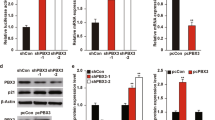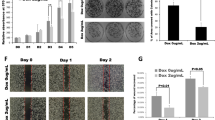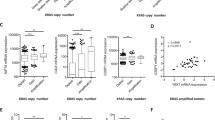Abstract
MKK4, located in close proximity to p53 gene, is thought to be a tumor suppressor and a metastasis suppressor gene. A low-rate MKK4 gene alteration has been found in a few tumor types, including breast and pancreatic. A suppressor activity for prostate and ovarian tumor metastasis has also been suggested. To understand the pathobiologic roles of MKK4 in tumorigenesis, we examined the phenotypic changes in response to perturbation of the MKK4 expression in breast and pancreatic cancer cell lines. Ectopic expression of MKK4 by adenoviral delivery in MKK4-negative cancer lines stimulated the cell proliferation and invasion, whereas knockdown of MKK4 expression by small interference RNA in an MKK4-positive breast cancer cell line, MDA-MB-231, resulted in decreased anchorage-independent growth, suppressed tumor growth in mouse xenograft model, and increased cell susceptibility to apoptosis brought by stress signals such as serum deprivation. These results argue that MKK4 functions as a pro-oncogenic molecule instead of a suppressor in breast and pancreatic tumors.
This is a preview of subscription content, access via your institution
Access options
Subscribe to this journal
Receive 50 print issues and online access
$259.00 per year
only $5.18 per issue
Buy this article
- Purchase on Springer Link
- Instant access to full article PDF
Prices may be subject to local taxes which are calculated during checkout





Similar content being viewed by others
Abbreviations
- JNK:
-
c-JUN NH2-terminal kinase
- LOH:
-
loss of heterozygosity
- MAPK:
-
mitogen-activated protein kinase
- MKK4:
-
mitogen-activated protein kinase kinase 4
- MKK7:
-
mitogen-activated protein kinase kinase 7
- MOI:
-
multiplicity of infection
- PBS:
-
phosphate-buffered saline
- PARP:
-
poly(ADP-ribose) polymerase
- PCR:
-
polymerase chain reaction
- PI:
-
propidium iodine
- RT–PCR:
-
reverse transcriptase–PCR
- siRNA:
-
small interference RNA
- TUNEL:
-
terminal deoxynucleotidyltransferase-mediated dUTP nick end labeling
References
Behrens A, Jochum W, Sibilia M and Wagner EF . (2000). Oncogene, 19, 2657–2663.
Bost F, McKay R, Dean N and Mercola D . (1997). J. Biol. Chem., 272, 33422–33429.
Chae KS, Ryu BK, Lee MG, Byun DS and Chi SG . (2002). Eur. J. Cancer, 38, 2048–2057.
Cryns V and Yuan J . (1998). Genes Dev., 12, 1551–1570.
Cuenda A . (2000). Int. J. Biochem. Cell Biol., 32, 581–587.
Dai JL, Bansal RK and Kern SE . (1999a). Proc. Natl. Acad. Sci. USA, 96, 1427–1432.
Dai JL, Schutte M, Bansal RK, Wilentz RE, Sugar AY and Kern SE . (1999b). Mol. Carcinogen., 26, 37–43.
Davis RJ . (2000). Cell, 103, 239–252.
Derijard B, Raingeaud J, Barrett T, Wu IH, Han J, Ulevitch RJ and Davis RJ . (1995). Science, 267, 682–685.
Ganiatsas S, Kwee L, Fujiwara Y, Perkins A, Ikeda T, Labow MA and Zon LI . (1998). Proc. Natl. Acad. Sci. USA, 95, 6881–6886.
Hess P, Pihan G, Sawyers CL, Flavell RA and Davis RJ . (2002). Nat. Genet., 32, 201–205.
Ip YT and Davis RJ . (1998). Curr. Opin. Cell Biol., 10, 205–219.
Johnson GL and Lapadat R . (2002). Science, 298, 1911–1912.
Kennedy NJ, Sluss HK, Jones SN, Bar-Sagi D, Flavell RA and Davis RJ . (2003). Genes Dev., 17, 629–637.
Kim HL, Vander Griend DJ, Yang X, Benson DA, Dubauskas Z, Yoshida BA, Chekmareva MA, Ichikawa Y, Sokoloff MH, Zhan P, Karrison T, Lin A, Stadler WM, Ichikawa T, Rubin MA and Rinker-Schaeffer CW . (2001). Cancer Res., 61, 2833–2837.
Knudson A . (1971). Proc. Natl. Acad. Sci. USA, 68, 820–823.
Lazebnik Y, Kaufmann S, Desnoyers S, Poirier G and Earnshaw W . (1994). Nature, 371, 346–347.
Lee HY, Srinivas H, Xia D, Lu Y, Superty R, LaPushin R, Gomez-Manzano C, Gal AM, Walsh GL, Force T, Ueki K, Mills GB and Kurie JM . (2003). J. Biol. Chem., 278, 23630–23638.
Lin A, Minden A, Martinetto H, Claret FX, Lange-Carter C, Mercurio F, Johnson GL and Karin M . (1995). Science, 268, 286–290.
Nishina H, Fischer KD, Radvanyi L, Shahinian A, Hakem R, Rubie EA, Bernstein A, Mak TW, Woodgett JR and Penninger JM . (1997). Nature, 385, 350–353.
Potapova O, Gorospe M, Bost F, Dean NM, Gaarde WA, Mercola D and Holbrook NJ . (2000). J. Biol. Chem., 275, 24767–24775.
Potapova O, Haghighi A, Bost F, Liu C, Birrer MJ, Gjerset R and Mercola D . (1997). J. Biol. Chem., 272, 14041–14044.
Rockwell SC, Kallman RF and Fajardo LF . (1972). J. Natl. Cancer Inst., 49, 735–749.
Schaeffer HJ and Weber MJ . (1999). Mol. Cell. Biol., 19, 2435–2444.
Su G, Hilgers W, Shekher M, Tang D, Yeo C, Hruban R and Kern S . (1998). Cancer Res, 58, 2339–2342.
Su G, Song J, Repasky E, Schutte M and Kern S . (2002). Hum. Mutat., 19, 81–85.
Sui G, Soohoo C, Affar EB, Gay F, Shi Y, Forrester WC and Shi Y . (2002). Proc. Natl. Acad. Sci. USA, 99, 5515–5520.
Teng DH, Perry WL, HOgan JK, Baumgard M, Bell R, Berry S, David T, Frank D, Frye C, Hattier T, Hu R, Jammulapati S, Janecki T, Leavitt A, Mitchell JT, Pero R, Sexton D, Schroeder M, Su PH, Swedlund B, Kyriakis JM, Avruch J, Bartel P, Wong AKC, Oliphant A, Thomas A, Skolnick MH and Tavtogian SV . (1997). Cancer Res, 57, 4177–4182.
Wang L, Duke L, Zhang PS, Arlinghaus RB, Symmans WF, Sahin A, Mendez R and Dai JL . (2003). Cancer Res., 63, 4724–4730.
Wu CW, Li AFY, Chi CW, Huang CL, Shen KH, Liu W-Y and Lin W-C . (2000). Am. J. Pathol., 156, 2007–2015.
Xiao L and Lang W . (2000). Cancer Res., 60, 400–408.
Yamada SD, Hickson JA, Hrobowski Y, Vander Griend DJ, Benson D, Montag A, Karrison T, Huo D, Rutgers J, Adams S and Rinker-Schaeffer CW . (2002). Cancer Res., 62, 6717–6723.
Yang D, Tournier C, Wysk M, Lu HT, Xu J, Davis RJ and Flavell RA . (1997). Proc. Natl. Acad. Sci. USA, 94, 3004–3009.
Yang YM, Bost F, Charbono W, Dean N, McKay R, Rhim JS, Depatie C and Mercola D . (2003). Clin. Cancer Res., 9, 391–401.
Yoshida BA, Dubauskas Z, Chekmareva MA, Christiano TR, Stadler WM and Rinker-Schaeffer CW . (1999). Cancer Res., 59, 5483–5487.
Acknowledgements
We thank Drs Roger Davis and Yang Shi for sharing plasmid constructs, Drs Timothy McDonnell and Eswaran Devarajan for valuable discussions, and Ms Lore Feldman for editorial comments.
Author information
Authors and Affiliations
Corresponding author
Rights and permissions
About this article
Cite this article
Wang, L., Pan, Y. & Dai, J. Evidence of MKK4 pro-oncogenic activity in breast and pancreatic tumors. Oncogene 23, 5978–5985 (2004). https://doi.org/10.1038/sj.onc.1207802
Received:
Revised:
Accepted:
Published:
Issue Date:
DOI: https://doi.org/10.1038/sj.onc.1207802
Keywords
This article is cited by
-
Metastasis suppressors: functional pathways
Laboratory Investigation (2018)
-
A survey of metastasis suppressors in Metazoa
Laboratory Investigation (2018)
-
JNKs function as CDK4-activating kinases by phosphorylating CDK4 and p21
Oncogene (2017)
-
Unique genetic profile of sporadic colorectal cancer liver metastasis versus primary tumors as defined by high-density single-nucleotide polymorphism arrays
Modern Pathology (2012)
-
EBP50 inhibits EGF-induced breast cancer cell proliferation by blocking EGFR phosphorylation
Amino Acids (2012)



